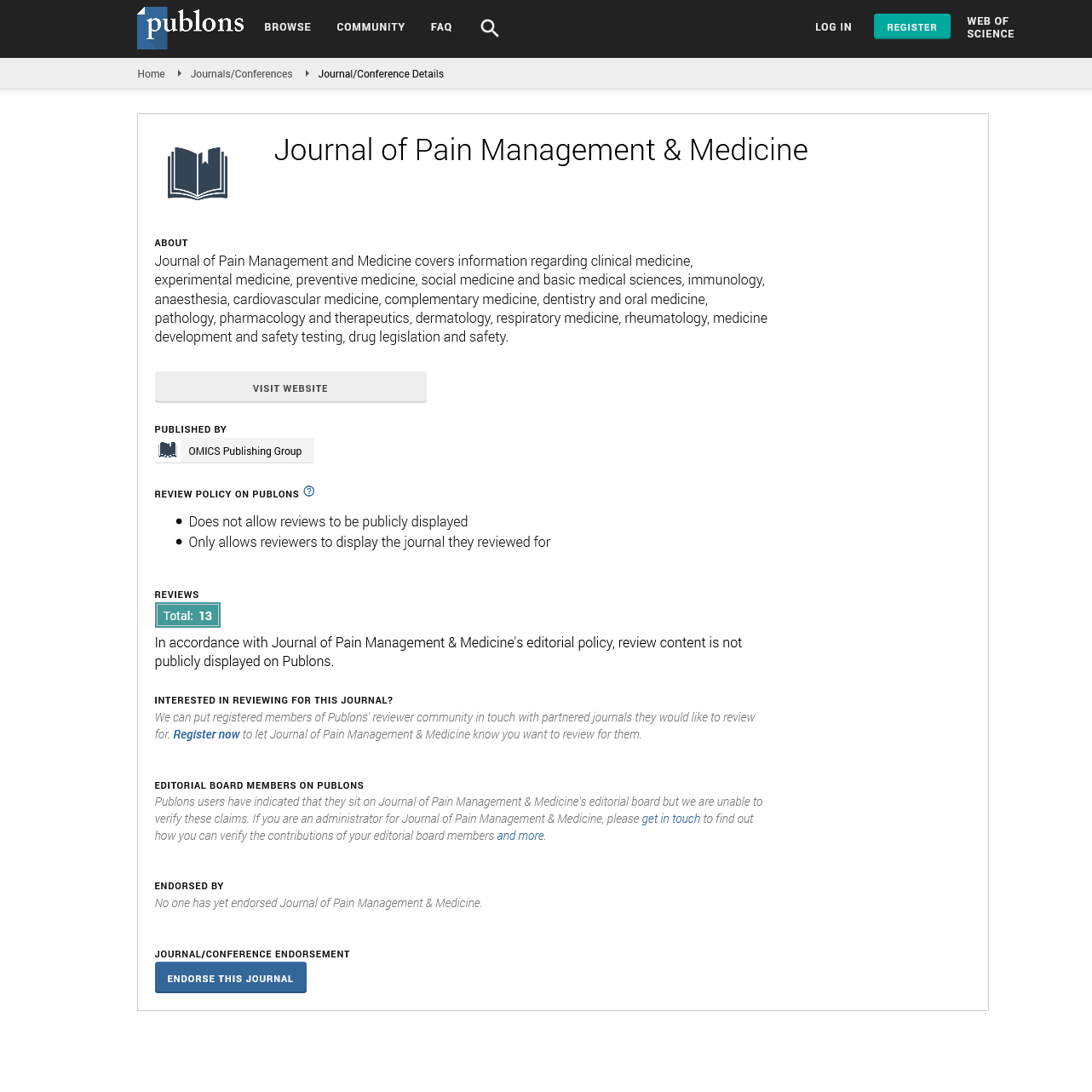Indexed In
- RefSeek
- Hamdard University
- EBSCO A-Z
- Publons
- Euro Pub
- Google Scholar
- Quality Open Access Market
Useful Links
Share This Page
Journal Flyer
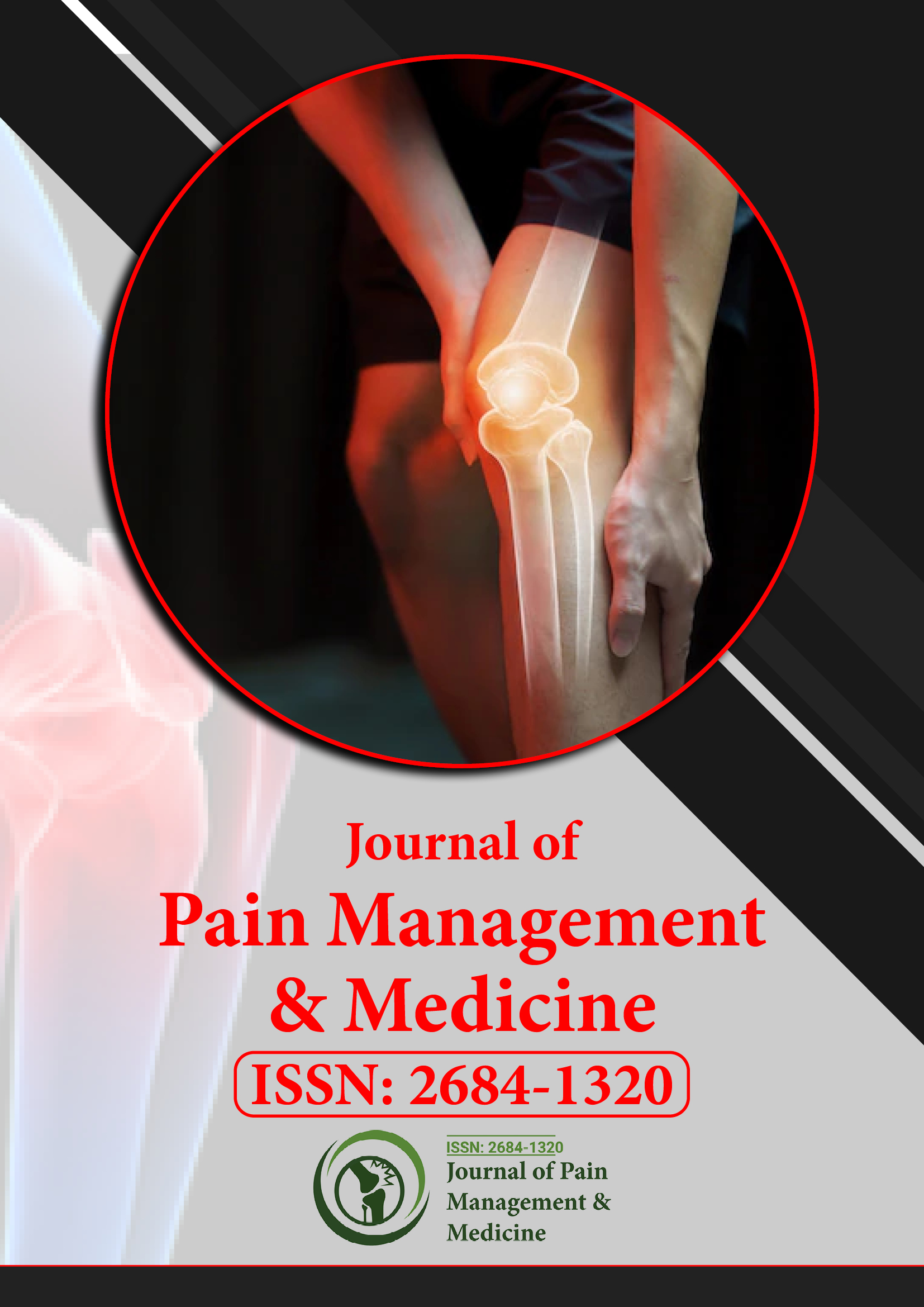
Open Access Journals
- Agri and Aquaculture
- Biochemistry
- Bioinformatics & Systems Biology
- Business & Management
- Chemistry
- Clinical Sciences
- Engineering
- Food & Nutrition
- General Science
- Genetics & Molecular Biology
- Immunology & Microbiology
- Medical Sciences
- Neuroscience & Psychology
- Nursing & Health Care
- Pharmaceutical Sciences
Mini Review - (2021) Volume 7, Issue 4
Adductor Canal Blocks Do Not Provide Superior Analgesia Compared to General Anaesthetic with Local Infiltration in ACL Reconstruction Surgery
Catherine Hatzantonis1*, Aashish Raghu2 and Yegappan Kalairajah32Department of Orthopaedics, Lister Hospital, Stevenage, United Kingdom
3Department of Trauma and Orthopaedic, Luton and Dunstable Hospital, Luton, United Kingdom
Received: 30-Jul-2021 Published: 20-Aug-2021, DOI: 10.35248/2684-1320.21.7.157
Abstract
Hatzantonis C, Raghu A, Kailairajah Y (2021) Adductor Canal Blocks Do Not Provide Superior Analgesia Compared to General Anaesthetic with Local Infiltration in ACL Reconstruction Surgery. J Pain Manage Med. 7:157.Keywords
Anterior cruciate reconstruction; Adductor canal block; General anaesthesia; Local anaesthesia
Introduction
Anterior cruciate ligament reconstruction surgery (ACLR) is commonly a day-case surgery. Post-operative pain following ACL reconstruction surgery is moderate to severe pain and lasts for nearly 72 hours [1,2]. Post-operatively, patients are often discharged home within 24 hours, when they are deemed ‘medically’ and ‘therapy’ fit [3,4]. They are safe to be ‘medically fit’ to be discharged home when their pain levels are well controlled, have adequate analgesia and less post-operative lower limb weakness.
There are various methods of regional anesthesia for ACL reconstruction surgeries. These are in combination with general anesthesia and include: femoral nerve block (FCB) [5], saphenous nerve block (also known as adductor canal block, ACB) [6], infiltration with local anesthesia [7] and recently IPACK Interspace between the popliteal artery and the capsule of the posterior knee [8]. It is noted that with the femoral nerve block, there is immediate post-operative quadriceps weakness which associated with immediate post-operative mobilisation, rehabilitation and increased length of hospital stay. However, in a recent study by Runner et al. no difference in post-operative quadriceps strength was noted in patients with femoral nerve blocks were compared with patients with adductor canal blocks [8].
The Adductor Canal Block (ACB) localises the saphenous branch of the femoral nerve and the nerve to vastus medialis, thus sparing the majority of the branches of the femoral nerve. Some studies have shown that ACB provides equal or superior analgesic effect to femoral nerve block with no quadriceps weakness whereas other studies have shown lesser analgesic effect [9] However, traditional methods of peri-articular infiltration with local anaesthesia (GALIA) also does not cause quadriceps weakness [10].
Most studies have discussed multimodal anaesthesia techniques like general anaesthesia, spinal anaesthesia and FCB vs. ACB [11,12], with sparse literature comparing ACB vs. LIA. Recently, studies comparing ACB versus LIA for post-operative pain management have come to light. A triple blinded RCT by Stebler et al. [12] included 104 patients, and the study revealed similar post-operative opioid consumption, postoperative pain scores and functional outcomes in the 24-hour post-operative period. Bangal et al. [13] compared 60 patients and demonstrated similar post-operative opioid consumption during the first 6 hours, but lesser post-operative opioid consumption in the ACB group as compared to the LIA group at the postoperative 12-hour period.
Our study aim is to compare the analgesic effiect of ultrasound guided adductor canal block (ACB) versus local intra-articular infiltration (LIA) on immediate post-operative pain management in patients undergoing arthroscopic ACL reconstructive surgeries.
Objective
To compare the analgaesic effects of an Adductor Canal Nerve Block (ACB) versus combined Local Anaesthetic with General Anaesthesia Infiltration (GALA) in patients undergoing ACL reconstruction.
Design
Retrospective Cohort Study
Setting
This study involved patients 100 patients undergoing ACL reconstructions at a single NHS hospital.
Participants
100 patients undergoing ACL reconstructions were involved in the study
Interventions
78 patients who had General Anaesthetic (GALA) versus 22 patients who had Adductor Canal Blocks (ACB).
Literature Review
This was a retrospective study where we reviewed a consecutive series of 100 patients who underwent ACL reconstructions (ACLR). Seventy-eight had General Anaesthetic with Local Infiltration Anaesthesia (GALIA) and 22 patients had Adductor canal blocks (ACB). This study occurred between January 2018 to December 2019 using inclusion and exclusion criteria (Figure 1). Basic demographic data of patients were included in Table 1 and included factors such as age, sex, BMI.
| Parameters | ACB | GALIA | P Value between ACB and GALIA |
|---|---|---|---|
| Age | 29.91 | 29.97 | 0.475 |
| Sex (M/F) | 20-Feb | 63/15 | 0.263 |
| BMI | 29.89 | 26.45 | 0.439 |
| ASA (I/II) | 17-May | 61/17 | 0.611 |
Table 1: Patient demographics values expressed as the mean for Adductor Canal Block (ACB) and General Anesthetic with Local Infiltration (GALIA). P-value calculated through chi squared test (95% CI).
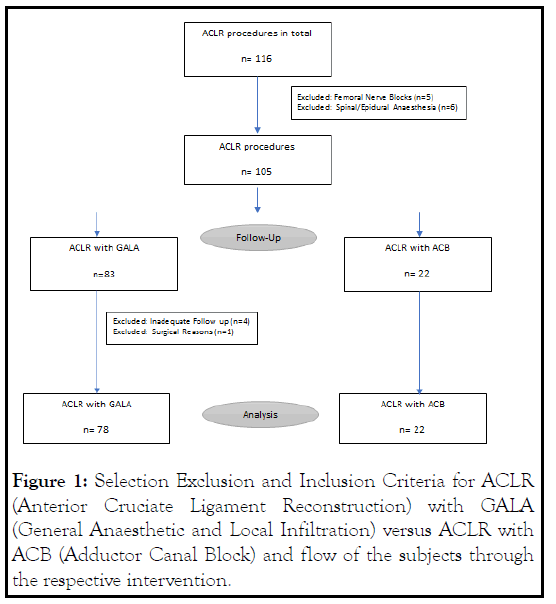
Figure 1: Selection Exclusion and Inclusion Criteria for ACLR (Anterior Cruciate Ligament Reconstruction) with GALA (General Anaesthetic and Local Infiltration) versus ACLR with ACB (Adductor Canal Block) and flow of the subjects through the respective intervention.
Inclusion criteria
1) Primary ACLR using a hamstring auto graft (Figure 1).
2) Subjects aged over 18 years (Figure 1).
Exclusion criteria
1) Reconstruction of the ACL tears using grafts other than hamstring autograft
2) Multi-ligament reconstruction and poor documentation of analgaesia or follow up (Figure 1).
ACLRs were performed arthroscopically with grafts through the tibial tunnel and an independently drilled femoral tunnel. All patients received a general anaesthetic on induction and maintenance medication at the discretion of the anaesthetists. Ultrasound guided ACB followed induction prior to incision using either 0.25% or 0.5% Bupivacaine as a single dose.
Outcome measures
Post-operatively, total oral morphine consumption within the first 8 hours post ACLR was calculated using drug charts and anaesthetic notes. The analgesia was measured in milligrams of oral morphine consumed using equianalgesic chart. VAS pain scores (Score 1-10) during this period were also recorded. The length of overall hospital stay k(days) was compared between the two groups (Table 2).
| Outcome measures | ACB | GALIA | P Value |
|---|---|---|---|
| Total Morphine (mg) consumption | 56.33 | 62.08 | 0.107 |
| VAS Score | 3.61 | 4.95 | 0.074 |
| Days inpatient in hospital | 1.95 | 1.99 | 0.421 |
Table 2: Mean opiate consumption, VAS scores and number of days in hospital post surgery (Adductor Canal Block vs. General and Local Infiltration). Values expressed as the mean for Adductor Canal Block (ACB) and General Anesthetic with Local Infiltration (GALIA). P-value calculated through Students t-test (95% CI).
Statistical analysis
SPSS software was used for statistical analysis of data. Continuous data between ACB and GALIA was analysed using Students t-test (unpaired). Chi-square tests were used for categorical data. Two tailed p-values <0.05 were considered statistically significant.
In total, 116 ACLR patients were identified, 100 (78 GALA and 22 ACB) met the inclusion criteria for analysis of early postoperative pain. The mean age was 29.9.
Demographic factors of age, sex, BMI, and ASA grades were demonstrated to have no statistical difference between groups of patients with adductor canal blocks or general anaesthetic with local infiltration with p-values of (0.475, 0.263, 0.439, and 0.411 respectively).
At first, the overall morphine consumption (mg) appeared higher in patients with general anaesthetic with local infiltration versus patients with adductor canal blocks, but the p-value was 0.107, demonstrating no statistical significance between the two groups. Days of inpatient admission echoed similar values of 1.95 in patients with ACB versus 1.99 in patients with GALIA and were deemed statistically insignificant with p-value of 0.421 (Table 2).
Finally, the VAS pain score was the most significant of the two groups, with average VAS pain scores of 3.61 for ACB versus 4.95 for GALIA with a p-value was 0.074, only just above the value of 0.05 acceptance for statistical significance (Table 2). (Figures 2a and 2b) also demonstrates a visible range of deviation between the values of both opioid consumption and VAS pain scores in both ACB and GALIA groups.
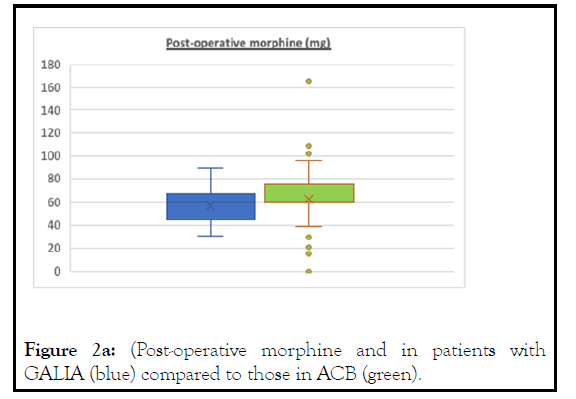
Figure 2a: (Post-operative morphine and in patients with GALIA (blue) compared to those in ACB (green).
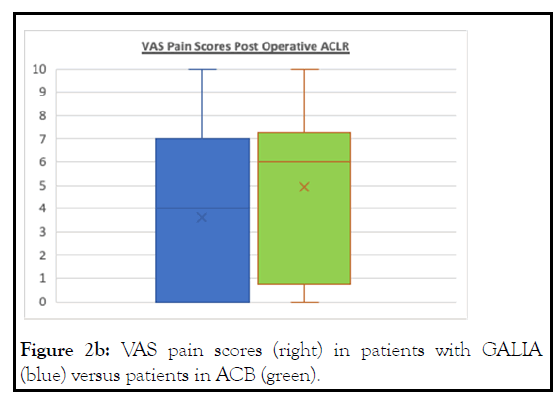
Figure 2b: VAS pain scores (right) in patients with GALIA (blue) versus patients in ACB (green).
Discussion
Arthroscopic ACLR is currently the mainstay of treating ruptured ACL ligament. One of the commonest techniques, the procedure involves harvesting the patient’s own hamstring tendons, usually semitendinosus and gracilis, for use as auto graft in ACL reconstruction. These grafts are then tunnelled into the distal femur and proximal tibia. This procedure can cause significant post-operative pain which requires adequate analgesia. ACLR is now performed as a day-case surgery which realises the need for effective long-lasting analgesia and maintenance of muscle strength for early mobilisation so that the patient can go home safely.
Various methods achieve post-operative analgesia for this surgery such as spinal anaesthesia (neuraxial block), general anaesthesia with femoral nerve block, saphenous nerve block, IPACK, local infiltration of anaesthesia and intra-articular infiltration of anaesthesia. Our study has compared analgesic effects adductor canal block with local infiltration of anaesthesia on a cohort of patients who underwent ACLR surgeries.
We report comparable post-operative VAS pain scores in the subjects of ACB group when compared to GALIA group and also similar outcomes in terms of total morphine consumption and number of day’s admission in hospital in the post-operative period.
Our results were similar to the randomised controlled trial conducted by Stebler et al. [12]. Who concluded that their cohort of 52 patients subjected to ACB and GALIA resulted in equivalent postoperative opioid consumption at 2 and 48 hours after surgery. Similar results were found in a randomised controlled trial by Kejriwal et al. found no difference in opioid consumption and VAS scores at 0,8- and 24-hours post-surgery.
However, a randomised prospective study by Bangal et al. [13,14] declared similar pain scores for the first 6 hours post-operatively in patients with spinal anaesthesia followed by ACB and GALIA groups but increased pain scores in the LIA group at postoperative 12 hours extending to 18 hours post-operatively. These values then remained with LIA group having a higher pain score at 24 hours.
Stebler et al. additionally assessed functional scores postoperatively and found no difference between the two groups in functional outcome in quadriceps strength, walking distance, or range of motion [12].
Conclusion
Compared with traditional GALA, ACB does not offer superior analgaesia to local anaesthetic and does not alter the length of hospital stay in patients undergoing anterior cruciate ligament reconstructions.
Acknowledgement
We appreciate that our study has taken into account a total morphine dose value rather than cumulative dose values. We also acknowledge a smaller sample size and the retrospective nature of the study. In addition, a trial with a longer postoperative comparison of 12- and 24-hour post-operative VAS scores and oral morphine consumption would have benefitted a comparison of longer-term comparison between these two forms of anaesthesia.
ACB confers as an additional invasive anaesthetic procedure which is more complex to perform in comparison to simple LIA which can be administered by the operating surgeon immediately upon closure.
We conclude that it would be helpful taking into account various other factors such as cost-effectiveness, time taken to administer the regional block, and preference and skill of the anaesthetist. These factors can then be used in conjunction with our findings in deciding the need for one anaesthetic technique or block as pre-operative planning management in patients with ACLR surgeries.
REFERENCES
- Williams BA, Kentor ML, Vogt MT, Irrgang JJ, Bottegal MT, West R, et al. Reduction of verbal pain scores after anterior cruciate ligament reconstruction with 2-day continuous femoral nerve block: a randomized clinical trial. Anesthesiology.2006; 104(2):315–327.
- Ambrosoli AL, Guzzetti L, Severgnini P, Fedele LL, Musella G, Crespi A, et al. Postoperative analgesia and early functional recovery after day-case anterior cruciate ligament reconstruction: a randomized trial on local anesthetic delivery methods for continuous infusion adductor canal block. Minerva anestesiologica. 2019; 85(9):962–970.
- Astur DC, Aleluia V, Veronese C, Astur N, Oliveira SG, Arliani GG, et al. A prospective double blinded randomized study of anterior cruciate ligament reconstruction with hamstrings tendon and spinal anaesthesia with or without femoral nerve block. The Knee. 2014; 21(5):911–915.
- Chisholm MF, Bang H, Maalouf DB, Marcello D, Lotano MA, Marx RG, et al. Postoperative Analgesia with Saphenous Block Appears Equivalent to Femoral Nerve Block in ACL Reconstruction. HSS J. 2014; 10(3):245–251.
- Albrecht E, Guyen O, Jacot-Guillarmod A, Kirkham KR. The analgesic efficacy of local infiltration analgesia vs femoral nerve block after total knee arthroplasty: A systematic review and meta-analysis. Br J Anaesth. 2016; 116(5):597–609.
- Sehmbi H, Brull R, Shah UJ, El-Boghdadly K, Nguyen D, Joshi GP, et al. Evidence Basis for Regional Anesthesia in Ambulatory Arthroscopic Knee Surgery and Anterior Cruciate Ligament Reconstruction: Part II: Adductor Canal Nerve Block-A Systematic Review and Meta-analysis. Anesth Analg. 2019; 128(2):223–238.
- Huang A, Singh PA, Woon KL. Interspace between the Popliteal Artery and the Capsule of the Knee (IPACK) Block for Anterior Cruciate Ligament Reconstruction Surgery: A Two Case Series. Open Journal of Anesthesiology. 2020; 10(04):134–143.
- Runner RP, Boden SA, Godfrey WS, Premkumar A, Samady H, Gottschalk MB, et al. Quadriceps Strength Deficits After a Femoral Nerve Block Versus Adductor Canal Block for Anterior Cruciate Ligament Reconstruction: A Prospective, Single-Blinded, Randomized Trial. Orthop J Sports Med. 2018; 6(9).
- Kirkham KR, Grape S, Martin R, Albrecht E. Analgesic efficacy of local infiltration analgesia vs. femoral nerve block after anterior cruciate ligament reconstruction: a systematic review and meta-analysis. Anaesthesia. 2017; 72(12):1542–53.
- Sehmbi H, Brull R, Shah UJ, El-Boghdadly K, Nguyen D, Joshi GP, et al. Evidence Basis for Regional Anesthesia in Ambulatory Arthroscopic Knee Surgery and Anterior Cruciate Ligament Reconstruction: Part II: Adductor Canal Nerve Block-A Systematic Review and Meta-analysis. Anesthesia and analgesia. 2019; 128(2):223–238.
- Ghodki PS, Shalu PS, Sardesai SP. Ultrasound-guided adductor canal block versus femoral nerve block for arthroscopic anterior cruciate ligament repair under general anesthesia. J Anaesthesiol Clin Pharmacol. 2018; 34(2):242–246.
- Stebler K, Martin R, Kirkham KR, Lambert J, De Sede A, Albrecht E. Adductor canal block versus local infiltration analgesia for postoperative pain after anterior cruciate ligament reconstruction: a single centre randomised controlled triple-blinded trial. Br J Anaesth. 2019;123(2): e343–e349.
- Bangal K, Ghodki P. Comparison of the efficacy of ultrasound guided adductor canal block versus intra-articular infiltration in providing post-operative analgesia after arthroscopic anterior cruciate ligament repair surgery. Indian Journal of Clinical Anaesthesia. 2020; 7(4):579–582.
- Kejriwal R, Cooper J, Legg A, Stanley J, Rosenfeldt MP, Walsh SJ. Efficacy of the adductor canal approach to saphenous nerve block for anterior cruciate ligament reconstruction with hamstring autograft. Orthop J Sports Med. 2018; 6(10).
Citation: Hatzantonis C, Raghu A, Kailairajah Y (2021) Adductor Canal Blocks Do Not Provide Superior Analgesia Compared to General Anaesthetic with Local Infiltration in ACL Reconstruction Surgery. J Pain Manage Med. 7:157.
Copyright: © 2021 Hatzantonis C, et al. This is an open-access article distributed under the terms of the Creative Commons Attribution License, which permits unrestrict ed use, distribution, and reproduction in any medium, provided the original author and source are credited.
